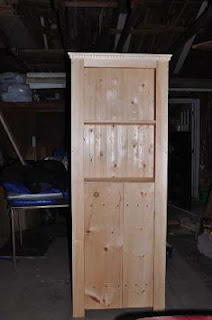Much spinning has happened lately as I get back into practice and homework mode for
Olds level 3. The more I practice the long draw, the more I enjoy it. This is a 3 ply, woolen spun, Falkland wool. The wool was sliver, so the end preparation is semi-worsted. It's very round, smooth and springy. I think this type of yarn would make an awesome hat with cables and it's likely what it will become.
More long draw with the trashy Shetland. It's a nice enough yarn when a short draw, worsted prep is used, but the long draw is perfect for this fibre. Despite all the VM, when spun with a long draw, it is soft, soft, soft, springy and luscious. I'm considering spinning up another skein of this as I think it would make a lovely gift. I'm pretty sure the recipient would be able to over look the VM is what otherwise is an awfully nice yarn.

There has been some knitting going on as well. I knit this pair of fingerless mitts from handspun Shetland. They are quite soft and will be perfect for fall spinning. Fingerless mitts also go by the older 1800's name of "muffatees" . I think that is a far more interesting word that just fingerless mitts. The lace pattern on the cuff was nicely repetitive, so it went fairly quickly.

I knit a Sontag! That's just a fancy, old-fashioned name for a shawl. Most of the sontags I've seen, tie behind the back. This one is loosely based on a pattern from either Godey's Ladies Book or Petersons. I tried it on before I'd blocked it. It was a tad too small to knot, so I added ties. Of course, when I soaked it, it relaxed and was much softer and larger when I blocked it. Once it's dry, I'll see if I really need those ties or not. They are only about 8-10 inches long, so they might only get in the way. Our house is cool in the winter and I'm hoping this will be nice and cozy. It's knit of handspun Shetland, from some of my first efforts with the longdraw. It sure was a lot of garter stitch knitting but the most tedious part was the cast off- 305 stitches made for a long time casting off.

It's finally harvest time. I made a lovely sweet veggie relish. It has cucumbers, sweet onions, green and red peppers and carrots, lots of yummy spices in sugar and apple cider vinegar. It is very tasty although I should have maybe cooked it a tad longer as it's just a little runny. The taste makes up for that though. The recipe barely fit in my largest pot and made a full 7 500 ml jars!
We won't have enough tomatoes from the garden this year. Not only has the dry weather affected the harvest bounty but we've some blossom end rot ( I think) and because of lack of moisture, most of the tomatoes are fairly small. I'm planning on a trip to the market for canning tomatoes.
 I did have to purchase the tomatoes this year...
I did have to purchase the tomatoes this year...




















